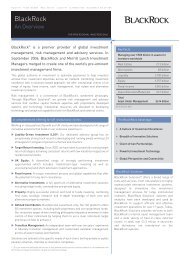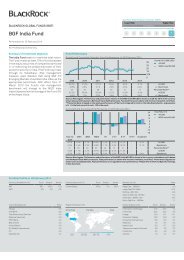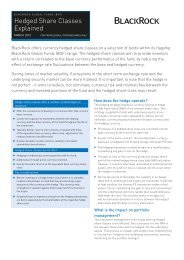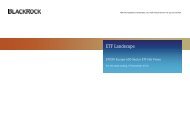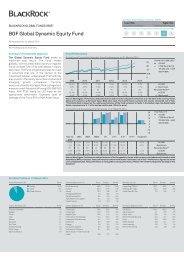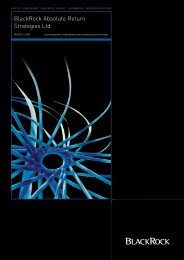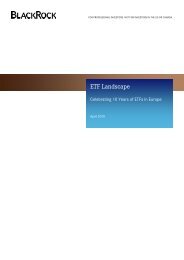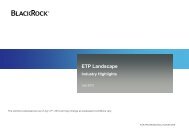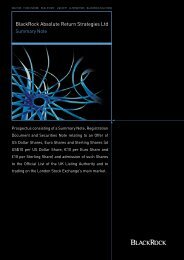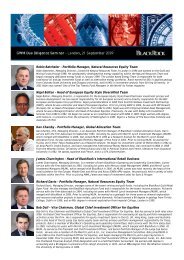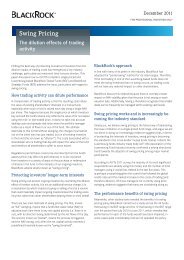ETF Landscape: United Kingdom Industry Review - BlackRock ...
ETF Landscape: United Kingdom Industry Review - BlackRock ...
ETF Landscape: United Kingdom Industry Review - BlackRock ...
You also want an ePaper? Increase the reach of your titles
YUMPU automatically turns print PDFs into web optimized ePapers that Google loves.
<strong>ETF</strong> <strong>Landscape</strong> Year End 2010<strong>United</strong> <strong>Kingdom</strong> <strong>Industry</strong> <strong>Review</strong> from <strong>BlackRock</strong>Changes to the <strong>United</strong> States tax law mayaffect non-<strong>United</strong> States resident holdersof <strong>United</strong> States <strong>ETF</strong>sFlow-through benefitsFunds registered under the Investment Company Act of 1940 andstructured for tax purposes as Regulated Investment Companies(RICs) under the <strong>United</strong> States Tax Code were previously allowed apackage of <strong>United</strong> States tax benefits to non-<strong>United</strong> Statesshareholders (generally called ‘flow-through’ benefits) as a result ofthe 2004 American Jobs Creation Act. These flow-through benefitsgenerally expired as of 31 December 2009.The three affected flow-through benefits are: Exemption from <strong>United</strong> States withholding tax (30% or lower treatyrate) on fund distributions where such distributions representQualified Interest Income (QII). QII is certain fund income derivedfrom interest income on debt of <strong>United</strong> States resident issuers (i.e.obligations issued by Treasury and <strong>United</strong> States corporations).This applied to fixed income <strong>ETF</strong>s. Exemption from <strong>United</strong> States withholding tax on any short-termcapital gains included in fund distributions. This applied to fixedincome and equity <strong>ETF</strong>s. Relief from <strong>United</strong> States Estate Tax on fund holdings by non-<strong>United</strong> States resident persons, where the underlying assetswould have been exempt from Estate Tax if held directly by thenon-<strong>United</strong> States resident person.The purpose of these three flow-through benefits was to allow anon-<strong>United</strong> States resident RIC shareholder the same treatment ona flow-through basis as if the investments were owned directly bythe non-<strong>United</strong> States resident RIC shareholder.On 17 December 2010, the President signed the Tax Relief,Unemployment Insurance Reauthorization, and Job Creation Act of2010 into law. According to this legislation, the items mentioned in1 and 2 above have been extended with respect to financial years ofthe fund beginning before 1 January 2012. The estate tax flowthroughmentioned in point 3 above has been extended to apply toestates of descendants dying before1 January 2012.Source: <strong>BlackRock</strong>.FATCA (foreign account withholding provisions in theHIRE Act)The <strong>United</strong> States Congress recently passed the HIRE Act, whichcontains provisions still commonly known as FATCA (the legislationpreviously being the Foreign Account Tax Compliance Act).FATCA is a system designed at getting financial institutions (of alldescriptions) around the world to identify <strong>United</strong> States investors –even where they hold indirectly via non-<strong>United</strong> States entities – andreport details of these to the IRS. This responds to high levels ofpolitical concern in the <strong>United</strong> States over tax evasion, especially bywealthy individuals.In order to encourage compliance with this legislation, the <strong>United</strong>States will from 1 January 2013 impose a 30% <strong>United</strong> Stateswithholding tax on the gross sales proceeds (as well as income)derived by any part of that financial institution from holdings of<strong>United</strong> States financial assets – unless that institution agrees toenter the reporting regime.Funds and fund managers are included in the definition of ‘ForeignFinancial Institutions’ (FFIs) and so FATCA goes greatly wider inreach than the existing ‘Qualified Intermediary’ system, with which itwill coexist.The impacts on the financial world are undoubtedly complex andpotentially far reaching. The basic wording of the HIRE Act leavesmany questions of detail unanswered, so financial institutions arewaiting keenly for draft regulations to be issued by the <strong>United</strong>States Treasury.It does however currently appear that holdings of <strong>United</strong> States<strong>ETF</strong>s by non-<strong>United</strong> States investors would be subject to the 30%withholding from gross sales proceeds, where held through a non-<strong>United</strong> States financial intermediary who does not become FATCAcompliant when the regime goes live in 2013.Source: <strong>BlackRock</strong>.We expect <strong>ETF</strong> assets to grow by20–30% in 2011The landscape will continue to evolve during 2011 and beyondas we see more products from traditional active asset managersand alternative asset class exposures becoming available to‘mainstream’ retail and institutional investors through standardisedand regulated fund structures such as UCITS in Europe.Hedge funds have historically been difficult for many investors toaccess with the high minimum subscription levels and maximuminvestor limits, but hedge funds are now noticing the growth andappeal of <strong>ETF</strong>s which are easy to access, but have powerfuldistribution networks. So we expect to see more hedge fundslooking to create <strong>ETF</strong>s, with their own funds as the underlyingexposure, in an effort to broaden their distribution capabilities.This will, on one hand, give more investors access to the asset classand the ability to do so in small sizes, with daily liquidity, but alsomake it challenging for them to understand what they are investingin compared to the historical daily transparency of the underlyingportfolio in low-cost index based exposures which <strong>ETF</strong>s havebecome known for.It will be important in the coming years to ensure that as newgenerations of <strong>ETF</strong>s come to market, investors are educated ontheir structures and mechanics when they deviate from thetraditional definition of <strong>ETF</strong>s.Traditionally <strong>ETF</strong>s are defined as exchange listed, open-ended, liquidwith secondary and primary in-kind creation and redemption (withsupport from market-makers and other liquidity providers), with realtime indicative Net Asset Value (NAV), and transparent where theunderlying portfolio is disclosed on a daily basis.11 This document is not an offer to buy or sell any security or to participate in any trading strategy. Please refer to important information and qualifications at the end of this material.



